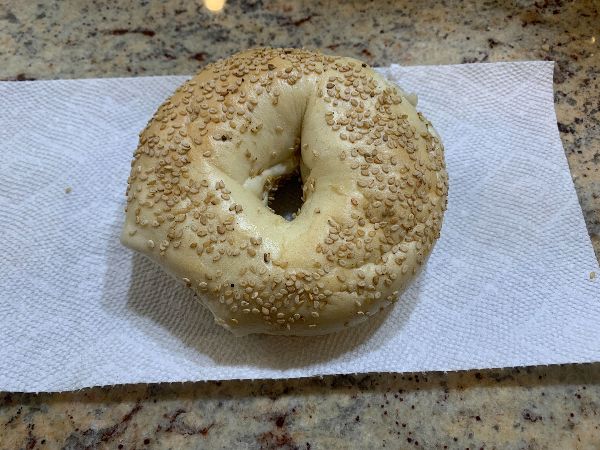The Sesame Seed Backlash of 2023?

On April 23, 2021, the United States government passed the Food Allergy Safety, Treatment, Education, and Research (FASTER) Act of 2021, which you can read here. It’s a short bill and a straightforward one: it requires food manufacturers, restaurants, and the like to disclose if a product contains sesame as of January 1, 2023. Allergen warnings for other foods — wheat, milk, soybeans, peanuts, and other ingredients — have been required by law in the U.S. for a long time, so this one shouldn’t have been much different. According to Food Allergy Research and Education, approximately one-quarter of one percent of the population — about 1.5 million Americans — have a sesame allergy, so if anything, the labeling should have been welcome news.
But if recent trends are any indicator, the opposite may be true. It has become a lot more difficult for sesame-allergic consumers to go out to dinner or buy some bread.
The problem is with a concept called “cross-contamination.”
Many products with sesame very clearly contain the seed; a sesame bagel, like the one above, clearly has sesame seeds on it. But if you’ve ever cooked with sesame seeds, you know that they get everywhere and are difficult to clean up. (You can even see a few rogue seeds in the picture above.) So if you’re a business that uses sesame seeds in one product, chances are there’s a little bit of sesame in basically everything you make. That’s called “cross-contamination.” While your sesame bagels clearly contain sesame seeds, there’s a chance that the blueberry muffins do, too; if you weren’t very, very careful, a few seeds from the bagels may have made their way into the muffin batter. While a couple of seeds probably won’t have a big impact on most sesame-allergic eaters, that’s not always the case. In some extreme examples, even tiny amounts of sesame can cause a reaction that can send someone to the emergency room or worse.
Before the FASTER Act went into effect, though, manufacturers and restaurants did not have to disclose if a product was potentially cross-contaminated with sesame. They could, voluntarily, inform customers that their potentially sesamized foods were “produced in a facility” that used sesame seeds, and many did. But under the FASTER Act, the food industry has to go further, as Mental Floss explains:
Those voluntary labels warning that some foods “may contain” an ingredient because they’re “produced in a facility” with known allergens? They are no longer enough. The new law requires products to state that an allergen is an ingredient, or to state that it unequivocally does not contain it.”
That’s a very difficult standard for many big American chain restaurants and food manufacturers to meet. Sesame seeds get into everything, so unless you’re running a sesame-free facility, cross-contamination is nearly unavoidable. As food safety consultant Nathan Mirdamadi told the Associated Press, “it’s as if we’ve suddenly asked bakers to go to the beach and remove all the sand.” So instead of taking steps to reduce cross-contamination, some companies are doing the opposite: they’re intentionally adding sesame to their products, and then labeling the foods as containing the allergen. The AP continues:
Officials at Olive Garden said that starting this week, the chain is adding “a minimal amount of sesame flour” to the company’s famous breadsticks “due to the potential for cross-contamination at the bakery.”
Chick-fil-A has changed its white bun and multigrain brioche buns to include sesame, while Wendy’s said the company has added sesame to its French toast sticks and buns.
United States Bakery, which operates Franz Family Bakeries in California and the Northwest, notified customers in March that they would add a small amount of sesame flour to all hamburger and hot dog buns and rolls “to mitigate the risk of any adverse reactions to sesame products.”
Understandably, advocates for those with allergies are furious with these decisions, with most seeing the move as corporate greed. One parent of a child with an anaphylactic sesame allergy told Buzzfeed that she “wonders how differently everything would have played out if companies announced they were adding peanuts to their products,” as peanut allergies are more in the public eye. And she’s probably right that the public reaction would be harsher — but it may not matter. In 2016, Kellogg’s had some cracker brands that could have been cross-contaminated with peanuts, so they attempted a similar strategy, adding peanut flour to those products and disclosing the presence of the allergen. After customers protested, Keebler reversed course somewhat, removing the peanut flour from some of the crackers — but not all of them. Even today, many Keebler crackers, such as the one for sale here, have “peanut flour” as one of the last ingredients, specifically so that the product can be labeled as “containing peanuts.”
Bonus fact: If you’re growing sesame in Mexico, chances are your seeds end up at McDonald’s. According to Mental Floss, as of 2014, “McDonald’s purchases approximately 75 percent of the sesame seed crop grown in Mexico, and their purchasing power parity influences global market pricing for sesame seeds every year.”
From the Archives: The Treat That Turned Into An Accidental Trick: The sesame seeds were probably the safest part of this burger’s bun.
